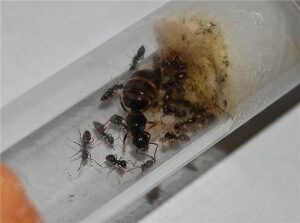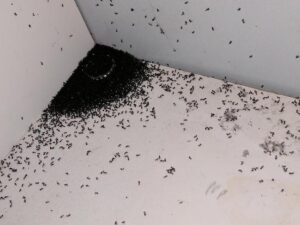
Ants are social insects that belong to the order Hymenoptera and the family Formicidae. They are highly organized and work together in colonies to ensure the survival of the colony. Here are some key characteristics and facts about ants:
- Social Structure: Ant colonies consist of three main castes: queens, males, and workers. Queens are responsible for laying eggs, males are involved in mating, and workers perform various tasks such as foraging, defending the colony, and caring for the young.
- Communication: Ants communicate primarily through pheromones, chemical substances that convey information. They use pheromones to leave trails for other ants to follow, mark food sources, and signal danger.
- Colony Organization: Ant colonies can vary greatly in size, from a few hundred to several million individuals. The colony is organized into different chambers or sections for specific purposes, such as brood care, food storage, and nesting.
- Life Cycle: Ants undergo complete metamorphosis, consisting of four stages: egg, larva, pupa, and adult. The time it takes to complete this cycle varies among species.
- Diet: Ants are omnivores, feeding on a wide range of food items including nectar, other insects, honeydew produced by aphids, and various organic matter. Some species are known for cultivating fungi as a food source.
- Nests: Ants build nests in a variety of locations, including soil, leaf litter, decaying wood, or even in living plants. The construction of nests depends on the ant species.
- Economic and Ecological Importance: Ants play a crucial role in ecosystems. They contribute to soil aeration, nutrient cycling, and seed dispersal. Some ants are predators of other insects and help control pest populations. However, some species can also be pests themselves.
- Defense Mechanisms: Ant colonies have various defense mechanisms, including biting, stinging, and producing formic acid. Some species also exhibit aggressive behavior to protect their nests.
- Variety of Species: There are over 12,000 known species of ants, and scientists estimate that there may be many more undiscovered species. Ants are found on every continent except Antarctica.
Ants are fascinating insects with complex behaviors and social structures that have captured the interest of scientists and observers alike.

- Seal Entry Points:
- Identify and seal any cracks, gaps, or openings in doors, windows, and walls that ants might use to enter your home.
- Use weather stripping to seal gaps around windows and doors.
- Clean Regularly:
- Keep your home clean, especially in areas where food is prepared or consumed.
- Wipe down surfaces, clean up spills promptly, and store food in airtight containers.
- Remove Food Sources:
- Keep pet food dishes clean and pick up any leftover food.
- Empty and clean trash bins regularly.
- Store food items in sealed containers.
- Use Ant Baits:
- Place ant baits near ant trails or entry points. Ants will carry the bait back to the nest, affecting the entire colony.
- Follow the instructions on the bait packaging for proper use.
- Diatomaceous Earth:
- Sprinkle food-grade diatomaceous earth around entry points and ant trails. It is a natural substance that can help control ant populations.
- Vinegar and Water Solution:
- Mix equal parts of white vinegar and water and use it to clean surfaces where ants have been spotted. The strong scent disrupts ant pheromone trails.
- Essential Oils:
- Ants dislike certain essential oils, such as peppermint, cinnamon, and tea tree oil. Mix a few drops with water and spray it around entry points or areas where ants are present.
- Boric Acid:
- Create a solution by mixing boric acid with sugar or honey. Place small amounts near ant trails, and they will carry it back to the nest. Be cautious with boric acid, especially if you have pets or small children.
- Cucumber Peels:
- Place cucumber peels near ant entry points or areas where they are active. Ants have a natural aversion to cucumber.
- Professional Pest Control:
- If the ant infestation persists, consider hiring a professional pest control service to assess and treat the problem.
It’s important to note that the effectiveness of these methods may vary depending on the ant species and the severity of the infestation. Consistency in implementing preventive measures and using targeted treatments will contribute to better ant control over time.
